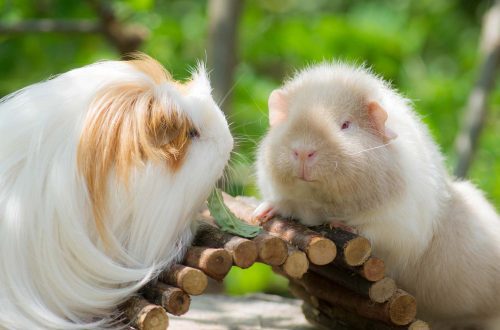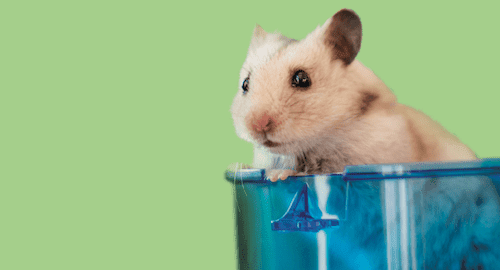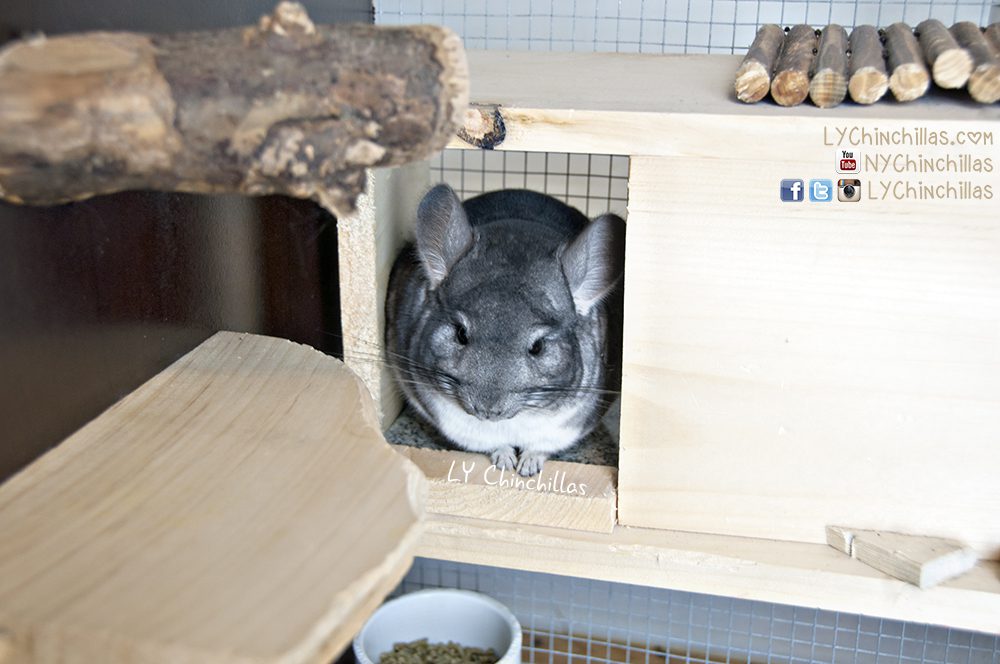
House for a chinchilla: choosing a finished one or creating it yourself – manufacturing materials, photos, drawings and dimensions
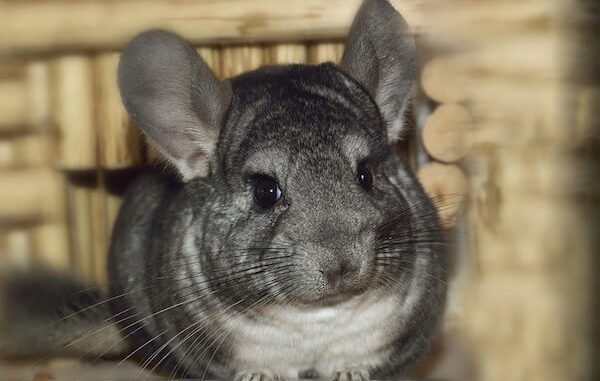
Among the various items and accessories in pet stores, you can see a variety of houses for chinchillas. How to choose the right home for a little pet and is it possible to make such a house on your own at home?
Contents
- Chinchilla house: purpose and installation
- Types, shapes and types of houses for chinchillas
- House for a chinchilla made of wood: advantages and disadvantages
- Ceramic house for chinchilla: pros and cons
- How to make a house for a chinchilla with your own hands
- Video: how to make a house for a chinchilla with your own hands
Chinchilla house: purpose and installation
A house for a fluffy pet is not just a beautiful accessory, but a necessary attribute designed to make keeping the animal cozy and comfortable. After all, the rodent should have a personal space where he can hide from prying eyes, eat his favorite treat and just relax.
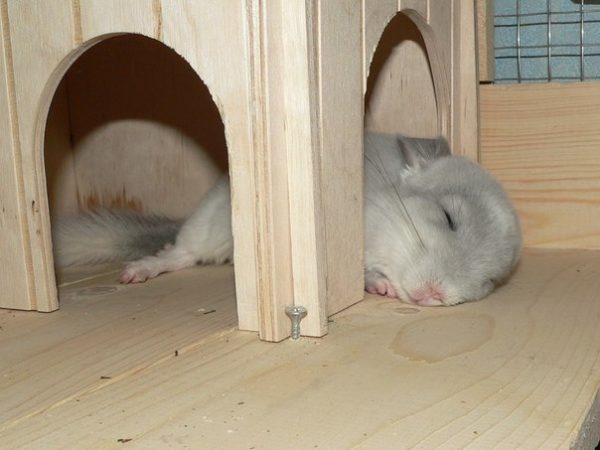
A house is needed for a chinchilla even if the owner plans to breed these animals. A separate house is simply necessary for a female who has babies. A newly-made mother needs a personal home where she can take care of her offspring without unnecessary looks.
As for the installation location of this accessory, it is placed in the least illuminated corner of the cage. Chinchillas, as a rule, sleep during the day and it is important that twilight reigns in the house during the daytime.
Important: for greater reliability and stability, it is better to put the house on the bottom of the cage. If the owner wants to install the dwelling on a shelf or purchase a hanging house, then it should be carefully attached to the rods so that the rodent does not fall with it and is not injured.
Types, shapes and types of houses for chinchillas
For the manufacture of houses, wood is most often used, but such accessories are also made from ceramics or plastic. Sometimes you can see the original dwellings for rodents made of straw or twine.
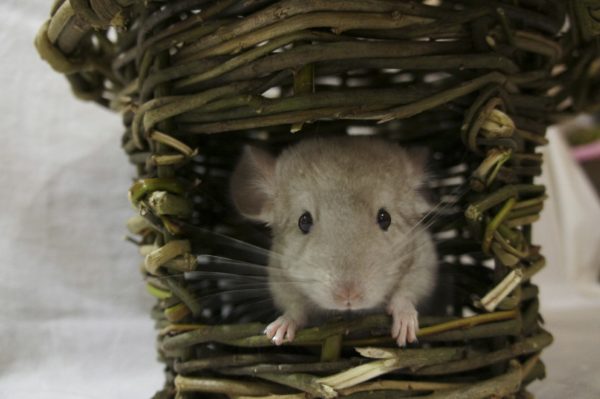
But the most popular houses among the owners of fluffy pets are still wooden dwellings, since straw, plastic and rope products do not last long.
As for the shape, the houses can be round, triangular, oval and rectangular. Dwellings for chinchillas are made in the form of rural huts, medieval castles and even Indian wigwams.
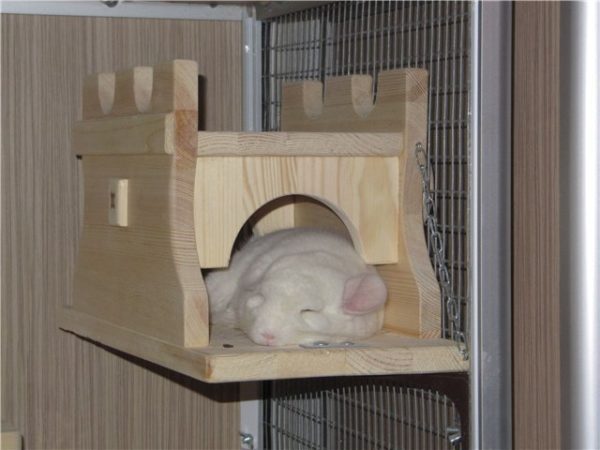
Which model to choose depends on the personal preferences of the owner and his financial capabilities.
And, before offering such an accessory to a small pet, you should know what criteria should be followed when choosing a home:
- the size of the house is chosen based on the size of the rodent. The chinchilla should fit freely in its home, and not experience inconvenience due to crowding;
- the design should not contain small holes in which the animal’s paw can get stuck;
- it is advisable to choose a product with several windows so that sufficient fresh air enters the house;
- it is better to purchase a dwelling for a chinchilla without a bottom, as it is easier to clean it;
- the roofs of the houses in the form of pointed domes are beautiful and original, but not safe for pets. A curious rodent, climbing onto such a roof, can slip off it and injure itself. Therefore, it is better to choose a flat-top design;
- a house for a chinchilla should not contain small parts that the animal can swallow (nails, screws).
Important: if the cage contains several fluffy pets, you should purchase a separate dwelling for each animal, otherwise fights between animals cannot be avoided.
House for a chinchilla made of wood: advantages and disadvantages
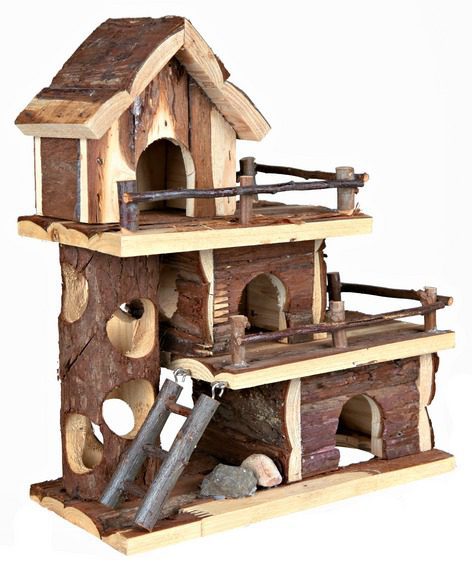
Most often, a cage of fluffy rodents is equipped with a wooden house. Wooden accessories are inexpensive, affordable and diverse in form and type of construction. Dwellings made of this material can be two- and three-story. Some of them are equipped with balconies and verandas, giving the products a more interesting and decorative look. You can also choose a house equipped with ladders and a running wheel, which saves a lot of space in the cage.
But the choice of a wooden dwelling for a small pet should be taken seriously and carefully, because products made from this material have both advantages and disadvantages.
The main advantages include:
- availability. In pet stores, wooden houses are presented in a wide range, and each owner will be able to choose an item to his taste;
- inexpensive price. The cost of wood products is relatively low, so it will not require significant financial expenses from the owner;
- they are easy to care for. Cleaning a wooden dwelling does not require much effort, it is enough to brush the house once a week and wipe all the details with a damp piece of cloth;
- big choice. Wooden houses are made in various shapes and sizes, so that each buyer can choose a product to his liking.
Cons of such products:
- often chinchillas spoil the house with their teeth and the owners often have to change the damaged accessory for a new one;
- the tree absorbs extraneous odors and, if the animal suddenly starts marking the house with its urine, the product will have to be thrown away;
- some houses are very light and not stable, so there is a risk that the animal will overturn it on itself or its neighbor in the cage;
- wooden dwellings are sometimes varnished. If a chinchilla gnaws at such a house and the varnish enters its body, then a case of poisoning is possible, sometimes even fatal;
- the same applies to the glue with which the walls of a wooden house are fastened together. Having swallowed glue, the animal runs the risk of getting diseases of the gastrointestinal tract, and then one cannot do without the help of a veterinarian;
- When choosing a wooden house for a chinchilla, you should make sure that all its details are carefully sanded. Otherwise, the rodent will cling to the notches, tearing out shreds of its luxurious fur coat.
Important: if the animal did not appreciate the owner’s gift and flatly refuses to even enter a new wooden house, it is worth checking if it has a too sharp or unpleasant odor.
Ceramic house for chinchilla: pros and cons
Ceramic products are not as popular among rodent enthusiasts as wooden accessories. But still, some owners, choosing a home for a fluffy pet, opt for a ceramic house.
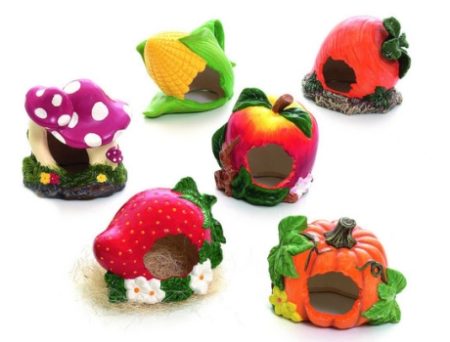
Made in the form of castles, towers, pumpkins or mushrooms, ceramic houses look like real works of art, but, as is the case with wooden products, they also have disadvantages.
Advantages of ceramic houses:
- accessories made of baked clay are beautiful in appearance and will be a wonderful decoration of the interior in a cage of a small animal;
- ceramic houses are quite heavy and stable, so animals cannot turn them over;
- a ceramic dwelling will last longer than wooden or plastic accessories, because the chinchilla will not be able to gnaw it;
- it is easy to wash and clean and cleaning it does not take much time;
- it is always cool inside the ceramic house, so in summer the animal will be especially comfortable in it.
Among the minuses can be noted:
- clay houses are considered a rarity, and not every pet store can buy them;
- such accessories are most often made to order, and the owner will have to pay a considerable amount for a ceramic product;
- sometimes ceramic houses are covered with low-quality chemical glaze, which releases toxins that are harmful to the body of animals.
How to make a house for a chinchilla with your own hands
Some owners prefer to make a house for their pet with their own hands. Indeed, in this case, the owner not only chooses safe materials, but can also come up with a unique and exclusive model of a home for a fluffy animal.
What materials and tools will be needed:
- wooden boards 1,5 cm thick;
- grinder or emery;
- hacksaw;
- pencil and ruler;
- drill;
- dowels for furniture.
If the owner decided to make a complex multi-storey structure, then first you need to sketch out the drawings for the future house on a piece of paper. And for a simpler model, you can immediately mark up the selected boards and start cutting out the details.
The first option: making a simple wooden house
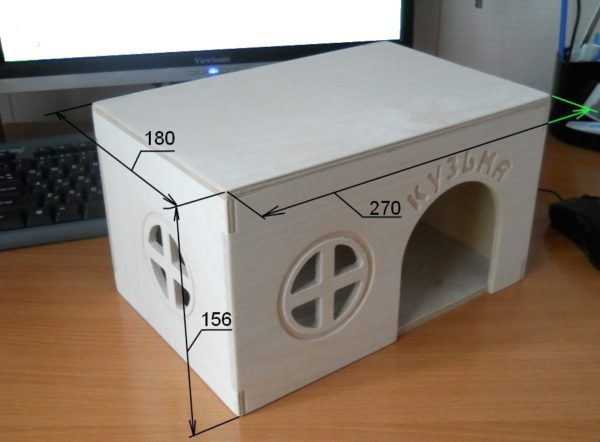
How to make a house:
- The dwelling for a rodent should be spacious, so the dimensions of the house are first calculated by drawing the measured contours with a pencil. The approximate dimensions of the house for one medium-sized chinchilla are 270mm * 180mm * 156mm.
- Cut out walls and roof.
- On the front wall draw silhouettes of the entrance and window. You can make windows on the side walls.
- The holes are cut out along the intended contour.
- The edges of the prepared parts are sanded, including the sawn windows and the entrance, so that they become even and smooth.
- In order not to use glue, holes for dowels are drilled in the walls and roof.
- Fasten all the details together with dowels.
- The gift for the animal is almost ready, it remains only to wipe it with a cloth dipped in water, to which a few drops of alcohol or vinegar are added to disinfect.
- Then the dwelling is dried and ventilated and the house is placed in the cage of your beloved pet.
- In order for the house to serve longer, you can upholster it with metal, since the chinchilla will definitely gnaw it.
The second option: making a two-story house
Based on the first method, you can make a two-story house. To do this, we will build one house larger than in the previous example and one smaller and connect them.
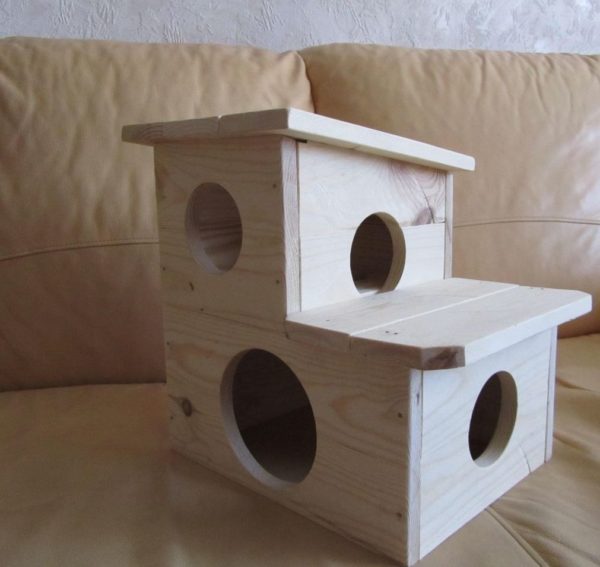
Third option: making an arch-shaped house
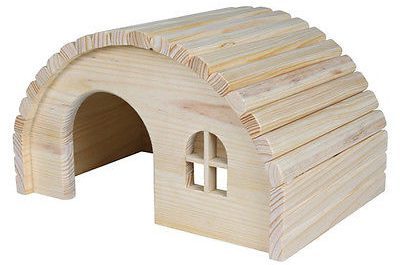
For him we need:
- a sheet of plywood 2 cm thick;
- small boards 3 cm wide and 2 cm thick;
- compass and ruler;
- Sander;
- drill;
- shkants.
Manufacturing instruction:
- On a sheet of plywood with a compass draw a circle with a radius of 14-16 cm.
- Cut out the circle and cut it into two equal parts. This will be the back and front wall.
- On the front wall we cut out a window and a door.
- We grind the edges of the parts.
- We cut the slats into pieces 18-20 cm long. We grind.
- With a drill, we drill holes for dowels on the rails and along the circumference on the walls. The distance between the holes is respectively 3 cm.
- We collect the product.
Important: a chinchilla can try its new home “by the tooth”, so oak wood cannot be used to make a house. The bark of this tree contains tannins, which, once ingested by a rodent, will provoke severe diarrhea.
Video: how to make a house for a chinchilla with your own hands
Chinchillas love secluded places and if they have nowhere to hide, they can get sick and even become depressed. Own cozy house will become a favorite place for rest and sleep of a fluffy pet, and the animal will be infinitely grateful to the owner for such a gift.
Homemade and purchased houses for chinchillas
3.9 (77.5%) 8 votes



